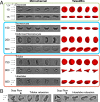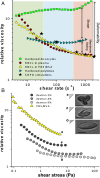Red cells' dynamic morphologies govern blood shear thinning under microcirculatory flow conditions
- PMID: 27834220
- PMCID: PMC5127344
- DOI: 10.1073/pnas.1608074113
Red cells' dynamic morphologies govern blood shear thinning under microcirculatory flow conditions
Erratum in
-
Correction for Lanotte et al., Red cells' dynamic morphologies govern blood shear thinning under microcirculatory flow conditions.Proc Natl Acad Sci U S A. 2016 Dec 13;113(50):E8207. doi: 10.1073/pnas.1618852114. Epub 2016 Nov 28. Proc Natl Acad Sci U S A. 2016. PMID: 27911850 Free PMC article. No abstract available.
Abstract
Blood viscosity decreases with shear stress, a property essential for an efficient perfusion of the vascular tree. Shear thinning is intimately related to the dynamics and mutual interactions of RBCs, the major component of blood. Because of the lack of knowledge about the behavior of RBCs under physiological conditions, the link between RBC dynamics and blood rheology remains unsettled. We performed experiments and simulations in microcirculatory flow conditions of viscosity, shear rates, and volume fractions, and our study reveals rich RBC dynamics that govern shear thinning. In contrast to the current paradigm, which assumes that RBCs align steadily around the flow direction while their membranes and cytoplasm circulate, we show that RBCs successively tumble, roll, deform into rolling stomatocytes, and, finally, adopt highly deformed polylobed shapes for increasing shear stresses, even for semidilute volume fractions of the microcirculation. Our results suggest that any pathological change in plasma composition, RBC cytosol viscosity, or membrane mechanical properties will affect the onset of these morphological transitions and should play a central role in pathological blood rheology and flow behavior.
Keywords: blood rheology; blood simulation; cell dynamics; red blood cell.
Conflict of interest statement
The authors declare no conflict of interest.
Figures





References
-
- Wells RE, Merrill EW. Shear rate dependence of the viscosity of whole blood and plasma. Science. 1961;133:763–764. - PubMed
-
- Dintenfass L. Internal viscosity of the red cell and a blood viscosity equation. Nature. 1968;219:956–958. - PubMed
-
- Chien S. Shear dependence of effective cell volume as a determinant of blood viscosity. Science. 1970;168:977–979. - PubMed
-
- Brust M, et al. Rheology of human blood plasma: Viscoelastic versus Newtonian behavior. Phys Rev Lett. 2013;110:078305. - PubMed
-
- Merrill EW, Gilliland ER, Lee TS, Salzman EW. Blood rheology: Effect of fibrinogen deduced by addition. Circ Res. 1966;18:437–446. - PubMed
Publication types
MeSH terms
LinkOut - more resources
Full Text Sources
Other Literature Sources

